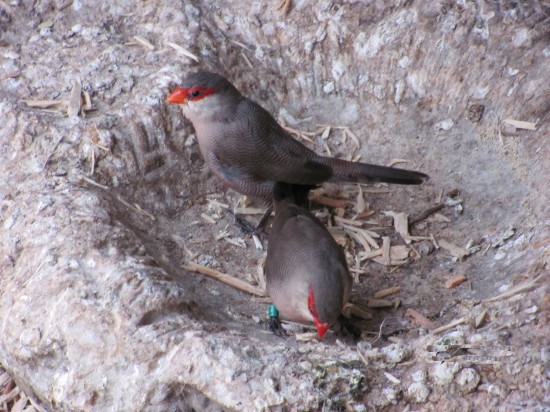

The term waxbill is used as a general term for the Estrildid finches but within that group are a branch of the family which are actually known as waxbills, the Estrilda genus. Some of these are kept in aviculture in this country, and some are kept abroad while others don’t seem to be bred in captivity at all. Here is a look at a few members of the family you might encounter if you decide to start keeping these beautiful little birds.
The Common Waxbill (Estrilda astrild) is also known as the St Helena Waxbill. They are a tiny bird from the sub-Saharan areas of Africa which reaches only 11-13cm in length. Both birds have a bright red beak, grey brown feathers with fine dark barring and a red stripe through the eye. Both the cheeks and throat are whitish, and the top of the breast has a pinkish flush.
In the wild, they live in open country with long grasses and vegetation or reeds and near water. They will also come to gardens, parks and farmland and will be quite calm around humans. They live in grass seeds as well as some insects, especially in breeding season. They are often found in flocks which can be thousands strong.
The nest is made from crisscrossed grass with a downwards pointed entrance on one side along a short tunnel. They build in low vegetation and sometimes a smaller, secondary nest is built on top, which is called a cock’s nest. This is where the male sleeps when the female is incubating. 4-7 eggs are incubated for 11-13 days and the chicks fledge around 17-21 days. Both birds incubate and feed the chicks. The nest of the Common Waxbill is parasitized by the Pin tailed Whydah but not to the detriment of the waxbill chicks. In captivity, they are prolific breeders and can produce four broods per year.
The Lavender Waxbill (Estrilda caerulenscens) is one of the most eye catching of the waxbill species in my opinion and is a common bird across Central Africa, as well as having been introduced into Hawaii. They are around 10 cm in length and are a mauve colour with crimson feathers on their lower back, tail and rump area. They also have a black band around their eye like a mask.
In captivity, they can be susceptible to the extreme cold of the British climate, so it is often best to keep them indoors or in a heated shed over winter. Always check with the breeder what conditions the birds have been raised with to avoid problems. They are also best living as a single pair, especially when breeding as can become very aggressive with anyone they see as a threat.
Lavenders will happily live on a foreign finch seed mix which is similar to the grass seeds they eat in the wild. The main thing to remember is these birds will be successfully raise young without live food and the protein it contains. This can be buffalo worms, pinkies or mealworms, and this again depends on the bird. There are mail order suppliers now who offer frozen live food or a local pet shop may have a supply.
When nesting, they can be intolerant of nest inspections so best to keep this to a minimum to avoid lost broods. Their nest is a grass construction with a cock’s nest sometimes on top with 4-6 eggs laid. The chicks fledge at 16-18 days and are weaned from around 20 days.
The Orange-cheeked Waxbill (Estrilda melpoda) is a finch from western and central Africa, which is found in family groups or flocks of up to 30 birds. Their habitat is the lowland wet shrubland habitats as well as the dry savannah areas, near watercourses and in gardens and farmland.
In captivity, their penchant for grass seeds means a good foreign finch mix will be a good basis for their diet. They also enjoying seeding grasses and foraging for them is good exercise. During breeding season, they need some life food and will eat small mealworms, fruit flies or even pinhead crickets, depending on the bird. A range of feeders should be available as they are quiet little birds who can be bullied away from the food.
The Orange cheeked build their nest in shrubbery or sometimes on the floor of their home, a tiny construction made from grasses. They will live and breed as pairs or in colonies.
The Black crowned Waxbill (Estrilda nonnula) is probably the least common in captivity in this country. It is usually around 11-12cm in length with a black head, ash grey across the back with fine barring, rump and upper tail deep crimson and a white face. Females are similar but less distinct barring of the feathers.
In the wild, they live in forest clearings, cultivated areas with plenty of bushes and on the edges of the forests. They eat grass seeds as well as catching flying termites and are found in large flocks. In captivity, they will eat millet, canary seeds and will enjoy honey water or nectar. Live food for breeding is crucial including white mealworms, buffalo worms and fruit flies.
In the wild, they nest in a tree up to 6 metres from the ground with several sites near each other. 4-6 eggs are laid and incubated for 11-13 days with the young fledging at 20-22 days of age.
These are the more common waxbill species currently being bred in this country, though a good pair of Lavender Waxbills can be over £100 a pair while the Common and Orange cheeked are less expensive. I personally haven’t seen a pair of black crowned for sale so cannot comment on prices. These are beautiful little birds who may need some protection from the worst of our feather and can be trickier to breed than some types of finches, but the pleasure of watching them outweighs this for me.
 How To Decide Upon A Puppy Food For Large And Giant Breeds Of Dog
How To Decide Upo
How To Decide Upon A Puppy Food For Large And Giant Breeds Of Dog
How To Decide Upo
 Japanese Akita Inu Dog Health And Longevity
Japanese Akita In
Japanese Akita Inu Dog Health And Longevity
Japanese Akita In
 Dalmatian Coat And Skincare
Dalmatian Coat An
Dalmatian Coat And Skincare
Dalmatian Coat An
 Eye Problems In The Miniature Pinscher And Similar Dog Breeds
Eye Problems In T
Eye Problems In The Miniature Pinscher And Similar Dog Breeds
Eye Problems In T
 Why Shouldn’t Dogs Eat Cat Food - An In-depth Examination
Why Shouldn’t Dog
Why Shouldn’t Dogs Eat Cat Food - An In-depth Examination
Why Shouldn’t Dog
Copyright © 2005-2016 Pet Information All Rights Reserved
Contact us: www162date@outlook.com